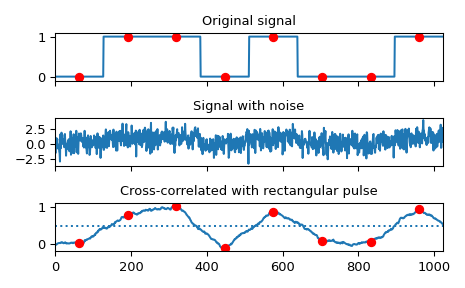correlate#
- scipy.signal.correlate(in1, in2, mode='full', method='auto')[source]#
对两个 N 维数组进行互相关。
对 in1 和 in2 进行互相关,输出大小由 mode 参数决定。
- 参数:
- in1array_like
第一个输入。
- in2array_like
第二个输入。应与 in1 具有相同的维度数。
- modestr {‘full’, ‘valid’, ‘same’}, 可选
一个字符串,指示输出的大小
full输出是输入的完整离散线性互相关。(默认)
valid输出仅包含那些不依赖零填充的元素。在 'valid' 模式下,in1 或 in2 必须在每个维度上至少与另一个一样大。
same输出大小与 in1 相同,并相对于 'full' 输出居中。
- methodstr {‘auto’, ‘direct’, ‘fft’}, 可选
一个字符串,指示用于计算相关性的方法。
direct相关性直接根据求和(相关性的定义)确定。
fft快速傅里叶变换用于更快地执行相关性计算(仅适用于数值数组)。
auto根据对速度的估计,自动选择直接法或傅里叶法(默认)。有关更多详细信息,请参阅
convolve注释。0.19.0 版本新增。
- 返回:
- correlatearray
一个 N 维数组,包含 in1 与 in2 的离散线性互相关的一个子集。
另请参阅
choose_conv_method包含有关 method 的更多文档。
correlation_lags计算一维互相关的时间滞后/位移索引数组。
备注
两个 d 维数组 x 和 y 的相关性 z 定义为
z[...,k,...] = sum[..., i_l, ...] x[..., i_l,...] * conj(y[..., i_l - k,...])
这样,如果
x和y是一维数组,并且z = correlate(x, y, 'full'),则\[z[k] = \sum_{l=0}^{N-1} x_l \, y_{l-k}^{*}\]对于 \(k = -(M-1), \dots, (N-1)\),其中 \(N\) 是
x的长度,\(M\) 是y\) 的长度,当 \(m\) 超出有效范围 \([0, M-1]\) 时 \(y_m = 0\)。\(z\) 的大小是 \(N + M - 1\),\(y^*\) 表示 \(y\) 的复共轭。method='fft'仅适用于数值数组,因为它依赖于fftconvolve。在某些情况下(即,对象数组或整数取整可能导致精度损失时),始终使用method='direct'。当对偶数长度输入使用
mode='same'时,correlate和correlate2d的输出会有所不同:它们之间存在一个索引偏移。示例
使用互相关实现匹配滤波器,以恢复通过噪声通道的信号。
>>> import numpy as np >>> from scipy import signal >>> import matplotlib.pyplot as plt >>> rng = np.random.default_rng()
>>> sig = np.repeat([0., 1., 1., 0., 1., 0., 0., 1.], 128) >>> sig_noise = sig + rng.standard_normal(len(sig)) >>> corr = signal.correlate(sig_noise, np.ones(128), mode='same') / 128
>>> clock = np.arange(64, len(sig), 128) >>> fig, (ax_orig, ax_noise, ax_corr) = plt.subplots(3, 1, sharex=True) >>> ax_orig.plot(sig) >>> ax_orig.plot(clock, sig[clock], 'ro') >>> ax_orig.set_title('Original signal') >>> ax_noise.plot(sig_noise) >>> ax_noise.set_title('Signal with noise') >>> ax_corr.plot(corr) >>> ax_corr.plot(clock, corr[clock], 'ro') >>> ax_corr.axhline(0.5, ls=':') >>> ax_corr.set_title('Cross-correlated with rectangular pulse') >>> ax_orig.margins(0, 0.1) >>> fig.tight_layout() >>> plt.show()

计算噪声信号与原始信号的互相关。
>>> x = np.arange(128) / 128 >>> sig = np.sin(2 * np.pi * x) >>> sig_noise = sig + rng.standard_normal(len(sig)) >>> corr = signal.correlate(sig_noise, sig) >>> lags = signal.correlation_lags(len(sig), len(sig_noise)) >>> corr /= np.max(corr)
>>> fig, (ax_orig, ax_noise, ax_corr) = plt.subplots(3, 1, figsize=(4.8, 4.8)) >>> ax_orig.plot(sig) >>> ax_orig.set_title('Original signal') >>> ax_orig.set_xlabel('Sample Number') >>> ax_noise.plot(sig_noise) >>> ax_noise.set_title('Signal with noise') >>> ax_noise.set_xlabel('Sample Number') >>> ax_corr.plot(lags, corr) >>> ax_corr.set_title('Cross-correlated signal') >>> ax_corr.set_xlabel('Lag') >>> ax_orig.margins(0, 0.1) >>> ax_noise.margins(0, 0.1) >>> ax_corr.margins(0, 0.1) >>> fig.tight_layout() >>> plt.show()
